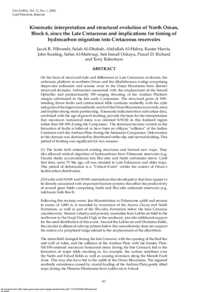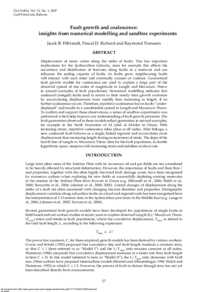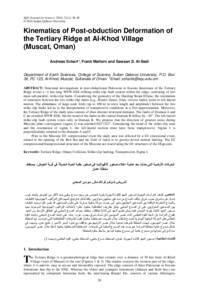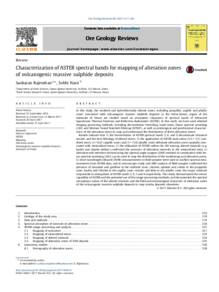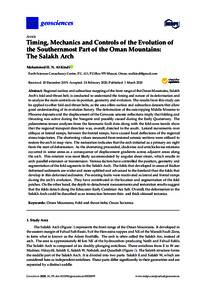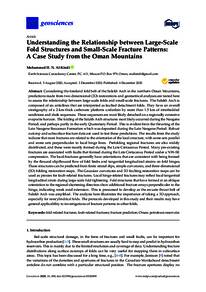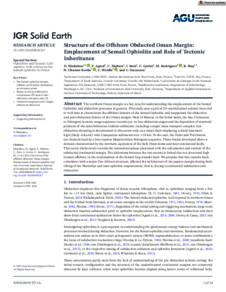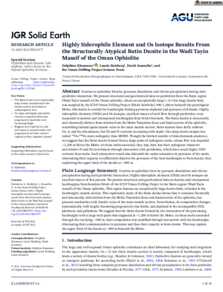وثيقة
Kinematic interpretation and structural evolution of north Oman, block 6, since the late cretaceous and implications for timing of hydrocarbon migration into cretaceous reservoirs.
المعرف
DOI: 10.2113/geoarabia110197
المصدر
GeoArabia. v. 11, 1, p. 97-140
المساهمون
Al-Dhahab, Salah., مؤلف
Al-Habsy, Abdullah., مؤلف
Harris, Kester., مؤلف
Keating, John., مؤلف
Al-Mahruqi, Salim., مؤلف
Ozkaya, Sait Ismail., مؤلف
Richard, Pascal D., مؤلف
Robertson, Tony., مؤلف
الدولة
Bahrain.
مكان النشر
Manama
الناشر
Gulf PetroLink.
ميلادي
2006-01-01
اللغة
الأنجليزية
الملخص الإنجليزي
On the basis of structural style and differences in Late Cretaceous evolution, the carbonate platform in northern Oman and the allochthonous wedge comprising deepwater sediments and oceanic crust in the Oman Mountains form distinct structural domains. Imbrication associated with the emplacement of the Semail Ophiolite and predominantly SW-verging thrusting of the Arabian Platform margin culminated in the late early Campanian. The structural grain of NW-trending thrust faults and contractional folds contrasts markedly with the style and grain of the region immediately south of the Oman Mountains (our study area) and implies strong strain partitioning. Kinematic indicators from subsurface data, combined with the age of growth faulting, provide the basis for the interpretation that maximum horizontal stress was oriented NW-SE in this foreland region rather than NE-SW during the Campanian. The dominant tectonic control on the formation of faults is believed to have been an oblique "collision" of the Indian Continent with the Arabian Plate during the Santonian-Campanian. Deformation in this domain was dominated by distributed strike-slip and normal faulting. This period of faulting was significant for two reasons: (1) The faults both enhanced existing structures and formed new traps. They also allowed vertical migration of hydrocarbons from Palaeozoic reservoirs (e.g. Haushi clastic accumulations) into Shu'aiba and Natih carbonates above. Until that time, some 75 Ma ago, oil was retained in Late Palaeozoic and older traps. This period of deformation is a "Critical Event" within the context of Oman's hydrocarbon distribution. (2) Faults with NNW and WNW orientations that developed a t that time appear to be directly associated with important fracture systems that affect the productivity of several giant fields comprising Natih and Shu'aiba carbonate reservoirs (e.g. Lekhwair, Saih Rawl). Following thi s tectonic event, late Maastrichtian to Palaeocene uplift and erosion in excess of 1,000 m, is recorded by truncation of the Aruma Group and Natih Formation, as well as part of the Shu'aiba Formation below the base Cenozoic unconformity. Seismic velocity and porosity anomalies from Lekhwair field in the northwest to the Huqf-Haushi High in the southeast, provide additional support for the areal distribution of this event. Around the Lekhwair and Dhulaima fields, the circular to elliptical subcrop pattern below this unconformity does not support the notion of a peripheral bulge related to the emplacement of the allochthon. The stress field changed during the late Cenozoic with the opening of the Red Sea and Gulf of Aden, and the collision of the Arabian Plate with the Iranian Plate. NE-SW-oriented maximum horizontal stress during the late Cenozoic led to the formation of major folds resulting in, for example, the surface anticlines over the Natih and Fahud fields as well as causing inversion along the Maradi Fault Zone. This may also have led to the uplift of the Oman Mountains. The regional northerly subsidence caused by crustal loading of the Arabian Plate gently tilted traps during the Pliocene-Pleistocene from Lekhwair to Fahud.
ISSN
1025-6059
قالب العنصر
مقالات الدوريات

